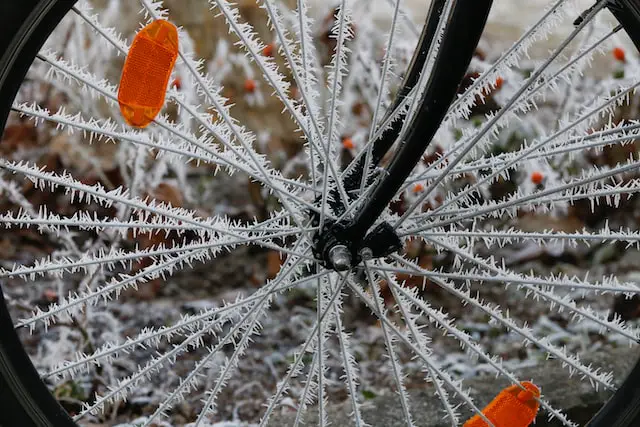Both hoarfrost and rime can form on exposed surfaces, such as leaves, grass, or car windows. Hoarfrost is made of ice crystals that form when water vapor condenses directly onto a cold surface. On the other hand, rime is made of tiny droplets of water that freeze instantly when they come into contact with a cold surface. Rime is usually found in colder climates, while hoarfrost can form in both cold and warm climates. Hoarfrost is also more delicate than rime and can easily be disrupted or melted.
What is hoarfrost?
(Photo by Georg Eiermann on Unsplash )

Hoarfrost is a type of ice that forms on objects when the temperature outside is below freezing and there is high humidity in the air. This usually happens overnight when the temperature drops and moisture in the air condenses on objects such as trees, power lines, and roofs. Hoarfrost looks like small, white crystals and can be easily mistaken for snow.
What is rime ice?
(Image by Myriams-Fotos from Pixabay )

Rime ice is a type of ice that forms on objects when the temperature is below freezing and the air is saturated with water vapor. It is composed of minute, needle-like crystals that form a white, crusty coating. Rime ice typically forms on exposed surfaces, such as tree branches, power lines, and buildings.
Hoarfrost Vs. Rime ice – Key differences
Hoarfrost and rime ice are both types of ice that form on surfaces in cold weather, but they form in different ways and have distinct characteristics.
Hoarfrost is formed when water vapor in the air freezes onto a surface, such as a tree branch or a car windshield. This typically occurs on cold, clear nights when the temperature drops below freezing and there is high humidity. The water vapor in the air freezes directly onto the surface as ice crystals, without passing through a liquid phase. Hoarfrost crystals are typically delicate and feathery in appearance, and can give surfaces a white, frosty appearance.
Rime ice, on the other hand, is formed when supercooled water droplets freeze onto a surface. Supercooled water is water that is in a liquid state but is below the freezing point, due to the absence of nucleation sites for ice crystals to form. When these droplets come into contact with a surface that is below freezing, they freeze onto the surface as ice. Rime ice crystals are typically denser and harder than hoarfrost crystals, and can form into a more solid, opaque layer on surfaces such as tree branches or rocks.
In summary, hoarfrost is formed when water vapor freezes directly onto a surface, while rime ice is formed when supercooled water droplets freeze onto a surface. They differ in their formation process, crystal structure, and appearance.
How to prevent hoarfrost?
Hoarfrost is a natural occurrence that is difficult to prevent entirely, as it forms when water vapor in the air freezes onto a surface. However, there are some steps you can take to minimize the formation of hoarfrost on surfaces such as car windshields or windows:
Use a windshield cover: A cover made specifically for car windshields can help to prevent the buildup of hoarfrost overnight. The cover can also help to protect the windshield from other winter weather hazards such as snow and ice.
Park in a garage or covered area: If possible, parking your car in a garage or covered area can help to reduce the formation of hoarfrost on the windshield and other surfaces.
Use a dehumidifier: Moisture in the air can contribute to the formation of hoarfrost. Using a dehumidifier in the affected area, such as a room or a car, can help to reduce the amount of moisture in the air and minimize the formation of hoarfrost.
Keep windows closed: Keeping windows closed when the temperature is below freezing can help to reduce the amount of moisture that enters the car or building, which can in turn help to reduce the formation of hoarfrost.
Use a windshield wiper fluid with antifreeze: Using a windshield wiper fluid that contains antifreeze can help to prevent the formation of hoarfrost on the windshield and other surfaces. The antifreeze component helps to lower the freezing point of water, preventing it from freezing onto surfaces.
While it may be difficult to prevent hoarfrost entirely, taking these steps can help to minimize its formation and make it easier to remove when it does occur.
How to prevent rime ice?
Rime ice is commonly seen on objects like power lines, trees, and fences. It forms when cold water droplets freeze onto surfaces that are already below freezing temperature. The droplets vaporize and turn into ice crystals that adhere to the surface.
There are a few ways to prevent rime ice:
- Use anti-icing solutions: Anti-icing solutions work by lowering the freezing point of water, so that it can no longer turn into ice. They are typically sprayed onto surfaces before winter weather hits.
- Keep surfaces clean: Ice tends to form more easily on dirty surfaces, so keeping things clean can help reduce the formation of rime ice.
- Apply heat: Applying heat to a surface will melt any existing ice and prevent new ice from forming. This can be done with a hairdryer, space heater, or even just the sun.
How is rime ice made?
Rime ice is made when the water droplets in fog freeze onto objects. The freezing process is known as deposition. For rime ice to form, the object must be cold enough so that the water droplets will freeze immediately upon contact. This type of ice typically forms on cold, clear nights when the humidity is high. The temperature difference between the air and the object is also a factor in determining whether or not rime ice will form.
Why is rime ice white?
Rime ice is white in color because it is made up of small ice crystals that reflect and scatter light in all directions. When light enters a rime ice crystal, it is refracted and scattered by the crystal’s irregular surface, which causes it to bounce around inside the crystal and be reflected back out in many directions. This scattering and reflection of light creates the appearance of whiteness, as all of the different wavelengths of light are scattered equally.
Another reason rime ice appears white is that it contains many tiny air pockets within its structure. These air pockets can also scatter and reflect light, adding to the whiteness of the ice.
It’s worth noting that rime ice can sometimes take on other colors, such as pink or orange, if it is illuminated by the sun during sunrise or sunset. This is because the angle of the sunlight passing through the atmosphere at those times can create a warmer, reddish hue. However, in general, rime ice appears white due to the scattering and reflection of light by its ice crystals and air pockets.
Is frost snow or ice?
Frost is neither snow nor ice, but rather a thin layer of ice crystals that forms on surfaces such as grass, leaves, or car windshields. It is formed by a process called deposition, in which water vapor in the air transforms directly into ice without going through a liquid phase.
Frost forms when the surface temperature of an object drops below the dew point temperature of the surrounding air, causing water vapor in the air to deposit as ice crystals on the object’s surface. The ice crystals that make up frost are generally small and delicate, and can resemble feathery or fern-like patterns on surfaces.
In contrast, snow is a type of precipitation that falls from clouds as frozen water droplets. It is made up of many individual ice crystals that have formed together, and can accumulate to form a thick layer of snow on the ground.
Ice, on the other hand, is a more solid and dense form of water that can occur in many different forms, including frozen lakes, glaciers, and icicles. It is typically formed from the freezing of liquid water, rather than from the direct transformation of water vapor into ice crystals.
In summary, frost is a thin layer of ice crystals that forms on surfaces, while snow is a form of precipitation made up of many individual ice crystals. Ice is a more solid and dense form of water that can occur in many different forms.
Featured Image By – Photo by Kym MacKinnon on Unsplash








